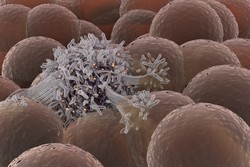Systems modelling of embryonal tumours
ETs such as neuroblastoma, medulloblastoma and Ewing sarcoma occur early in life and are highly aggressive. Investigation of these tumours provides the opportunity to identify key lesions clearer than adulthood tumours, which carry passenger mutations accumulated during life. The EU-funded ASSET (ASSET: Analysing and striking the sensitivities of embryonal tumours) project combined state-of-the-art genomics, transcriptomics, proteomics and mathematical modelling to address this and provide insight into the pathogenesis of ETs. The consortium worked under the rationale that ETs share common aberrations in core signalling networks, and so set out to map them and identify novel therapeutic targets. Advanced omics technologies and computational techniques helped understand pathway and network aberrations. An important innovation developed in ASSET was the use of mathematical models as highly accurate biomarkers for patient stratification and therapy choice. This allowed the consortium to capture the pathogenic mechanisms implicated in ETs. In neuroblastoma, telomerase aberration was identified as a high-risk biomarker, and is expected to substantially improve disease classification and risk prediction at the time of diagnosis. For the design and development of novel treatments, the consortium followed a holistic, integrated systems pharmacology approach that identified several drug target candidates, druggable pathways and growth inhibitory compounds. Additionally, molecules for miRNA-based therapeutics were discovered, which either compensated missing tumour-suppressive miRNAs or neutralised oncogenic miRNAs in ETs. Considerable effort went towards understanding the biology behind MYCN (v-myc avian myelocytomatosis viral oncogene neuroblastoma-derived homologue) overexpression that marks a clinically very challenging neuroblastoma patient group. Furthermore, researchers identified a novel vulnerable cancer hallmark associated with replicative stress resistance. From a therapeutic perspective, data integration of omics approaches led to the discovery of molecular targets within the MAPK and Wnt signalling pathways and approaches to tackle MYCN, c-Myc and EWS-FLI1 in ETs. Interestingly, scientists observed that drugs exhibited different efficacies depending on the time of administration. Overall, ASSET's mechanistic insight into ET pathogenesis will help to stratify patients and bridge the gap between scientific discovery and applied research. From molecular targets to novel drug combinations, project deliverables are destined to improve the currently dismal outcome of young patients with ETs.







